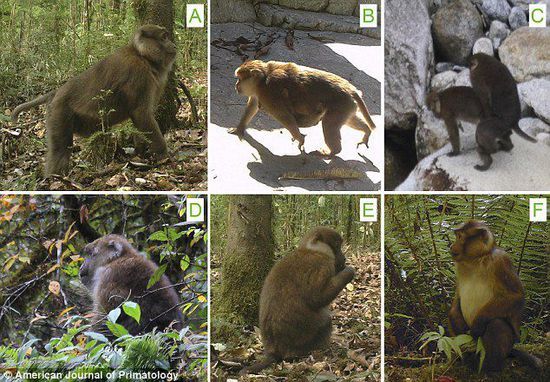
Chinese experts claim to have discovered a new species of macaque and now the race is on to protect it.
The new monkey species - found in southeast Tibet's Modog County - has been named the white-cheeked macaque.
Although the discovery was only published last month on the website of American Journal of Primatology, experts say it is already feeling the stress of human encroachment and activities.
Chinese wildlife photographer Li Cheng first identified the new species after he heard its call in the woods in 2012.
"It was a high-pitched 'Yi-ou' - I had never heard such a call from a macaque before," Li recalls. However, the group of around 10 macaques vanished into the woods before he could make them out.
In October 2013, Li joined a field survey of wild species in Tibet. He set 31 cameras in the primeval forest in Modog. Motion sensors triggered the cameras to take three images and a 15-second video each time they detected movement.
Half a year later, he had 738 photos and more than 100 videos of the "special macaques" of Modog.
In December 2014, Fan Pengfei, an associate professor of primate studies in Dali University, and Zhao Chao, a researcher at Southwest Forestry University, both claimed to have seen the "special macaques" in Modog.
From the photographs, Li, Fan and Zhao determined the species appeared distinct from all known species of macaque.
Their most distinguishing feature - and the source of its name - was the regular off-white fur on the cheeks of the adults.
Other distinctive traits included long, thick hair on the neck, a relatively hairless short tail, dark skin on the muzzle, and round rather than arrow-shaped male genitalia.
A sonogram made by Peng highlighted the white-cheeked macaque's high-pitched alarm call, which was unlike the low-pitched bark of macaques in southwest China.
"Due to ethical concerns about killing wild primates, we did not obtain a specimen, so our study was based on photographs and analysis of its physical attributes to determine it was a new morphospecies," Peng says.
"Currently, Modog is the only known habitat of the white-cheeked macaque, though its range may extend to neighboring counties in China and regions of southeast Tibet controlled by India," says Li, who estimates the population at about 500.
Discoveries of new species of mammals - especially primates - are rare, says Li Baoguo, president of the China Primatological Society. "The white-cheeked macaque is the second new species of macaque recorded in the past century. This discovery is significant in the study of biodiversity changes caused by human activities."
It also highlights the need for biodiversity conservation in southeast Tibet, said Li, who wants more intensive surveys, studies and environmental protection in the area.
"We will look for excrement or fur of the animal for DNA testing to understand it better, and we'll further explore its habitat and distribution," says Peng.
Ranging from tropical forest to alpine conditions, Modog is a biodiversity-rich area in the eastern Himalayan region.
Though slash-and-burn land clearance has long been prohibited in Modog, it is still threatened by human activity, the research article said.
The hunting traditions of local minority groups, such as the Menba and Luoba, used to include hunting macaques, according to long-time expert Guo Guangpu, a lecturer at the School of Life Sciences and Technology, Tongji University.
Awareness of the need for ecological protection has grown in recent years, but some people still use wire snares to capture wild animals, including macaques, he says.
Local government plans to build hydropower stations could also affect the macaques' habitat, the article said.
Guo wants hydropower projects to fully consider the possible ecological impacts and avoid flooding extensive areas of forest, which could be home to the white-cheeked macaque and other unique creatures.
"Numerous species, known and unknown, live in the primeval forest," says Zhao. "The forest is like an ancient museum of nature, home to many unique animals, and we have seen only a few of them."
















































